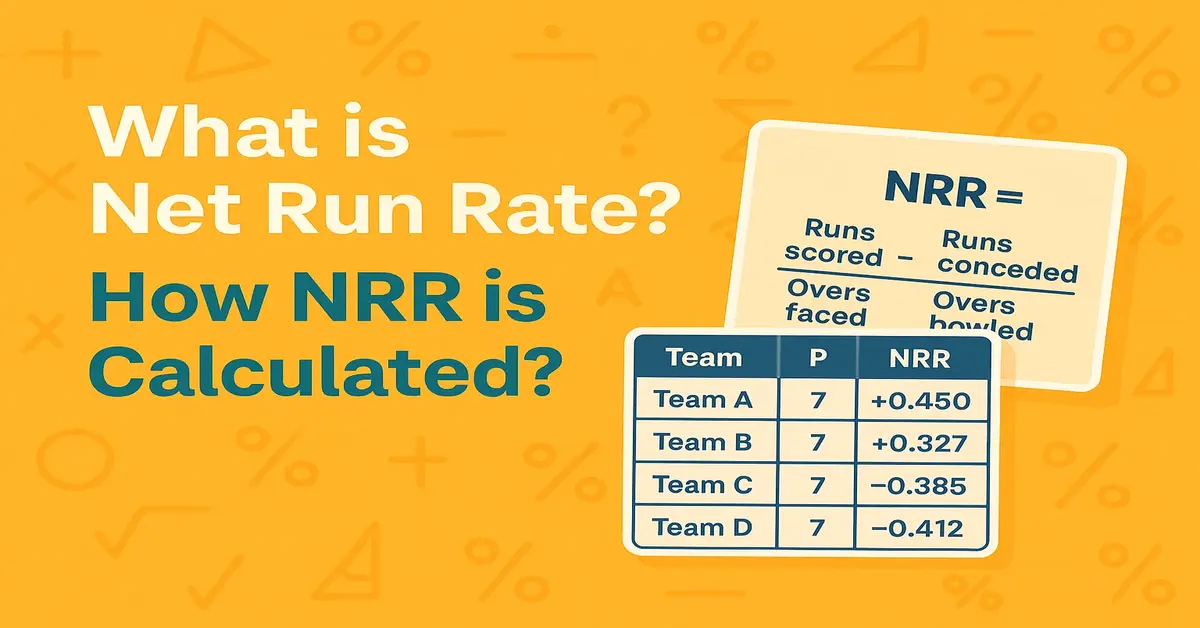What is Net Run Rate? How NRR is Calculated?
Net Run Rate (NRR) is a key statistical metric used in cricket, especially in tournaments like the IPL, World Cups, and other league-stage competitions, to rank teams when they have equal points.
Background of Net Run Rate (NRR)
Net Run Rate was introduced as a fair and data-driven method to differentiate teams with the same points in tournaments that follow a league or round-robin format.
When did it begin?
- The concept of Net Run Rate began gaining prominence in the late 1980s and early 1990s, during ICC-organized tournaments.
- It became the official tie-breaking system for the 1992 Cricket World Cup, replacing the older run average system.
Why was NRR needed?
Before NRR, teams were ranked by run average:
RunAverage=TotalRunsScored/TotalWicketsLostRun Average = Total Runs Scored / Total Wickets LostRunAverage=TotalRunsScored/TotalWicketsLost
This system unfairly penalized teams for losing wickets, even in matches they won.
NRR rewards teams for:
- Winning convincingly (by big margins)
- Chasing targets quickly
- Keeping opposition scoring in check
It was seen as a more balanced metric, reflecting both batting and bowling efficiency.
So, What is Net Run Rate?
Net Run Rate (NRR) measures a team’s overall scoring rate versus how much they concede, across all matches in a tournament.
In simple terms:
NRR = (Total Runs Scored / Total Overs Faced) – (Total Runs Conceded / Total Overs Bowled)
How to Calculate Net Run Rate?
Let’s break it down:
Net Run Rate Formula:

Key Rules to Remember:
- Full 20 Overs Count
If a team bats the full 20 overs, all 20 are counted — even if they are bowled out earlier. - Chasing Teams
If a team chases the target, only the overs they took to win are counted (not unused ones). - Abandoned Matches
Matches with no result or washouts are not included in NRR calculation. - NRR is Cumulative
It’s calculated using total runs and overs from all matches played so far in the tournament.
Example:
Match 1:
- Team A: 160/5 in 20 overs
- Team B: 150/8 in 20 overs
Team A wins.
- Team A: Scored 160 in 20 overs = 8.00 RPO
- Team A conceded 150 in 20 overs = 7.50 RPO
NRR for Team A = 8.00 – 7.50 = +0.50
NRR for Team B = 7.50 – 8.00 = -0.50
Here’s a handy little NRR calculator for you!
🏏 Team A vs Team B – Net Run Rate Calculator
Team A
Team B
Why NRR in Cricket Matters?
In tight tournaments like the IPL or World Cup, teams with equal points are ranked using NRR. It often becomes the deciding factor for qualification to playoffs or semifinals.
Net Run Rate Criticism
Despite its utility, NRR has been criticized for being:
- Hard to understand for casual fans
- Highly sensitive to one or two big-margin games (can distort rankings late in tournaments)
That’s why newer suggestions like Head-to-Head results and Bonus Points are sometimes debated, but NRR still remains the default system in most ICC and franchise tournaments (like IPL, World Cup, PSL, etc.).
Frequently Asked Questions (FAQs) on Net Run Rate:
1. What is Net Run Rate (NRR) in cricket?
Net Run Rate (NRR) is a statistical method used in limited-overs cricket to rank teams that have equal points in a league or tournament. It calculates the difference between the average runs per over a team scores and the average runs per over it concedes throughout the competition.
2. How is Net Run Rate calculated?
NRR is calculated using the formula:
NRR = (Total Runs Scored /Total Overs Faced) – (Total Runs Conceded /Total Overs Bowled)
This calculation is typically performed across all matches in a tournament.
3. Why is NRR important in cricket tournaments?
NRR serves as a tiebreaker when teams have equal points in a league or group stage. A higher NRR can determine which team advances to the next round or secures a better position on the points table.
4. Does NRR consider wickets lost?
No, NRR does not account for wickets lost. It solely focuses on the rate at which runs are scored and conceded per over. This means a team can have a high NRR even if it loses many wickets, as long as it maintains a high scoring rate. Wikipedia
5. Can a team with a lower NRR qualify over a team with a higher NRR?
Yes, if a team has more points than another, it will rank higher regardless of NRR. NRR is only used to separate teams that are equal on points. Source: Wikipedia
6. How do rain-affected matches impact NRR?
In rain-affected matches, the Duckworth-Lewis-Stern (DLS) method adjusts targets. For NRR calculations: Source: Wikipedia
- If a match is abandoned without a result, it’s typically excluded from NRR calculations.
- If a result is achieved using DLS, the adjusted targets and overs are used in the NRR computation.
7. Is there a difference in NRR calculation across different cricket formats?
The basic formula for NRR remains consistent across formats like ODIs and T20s. However, the shorter nature of T20 matches means that small differences in scoring rates can have a more significant impact on NRR.

